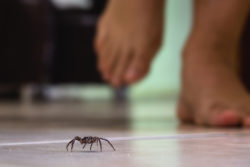Seeing a spider run across your floors will often cause panic! While it’s never ideal to see one, most often the spiders that have infested our homes are harmless. But, if you are able to identify these pests, it can help lessen the panic and allow you to place the proper techniques to remove and prevent them from infesting again. Check out our list of common spiders you could see in your Florida home or property.
Wolf Spider
The wolf spider is one of the larger species found in Florida, growing between .4” and 2” (10-50mm). These creatures have furry coats, large bodies, thick fuzzy legs, and sometimes striped legs. To tell them apart from other spiders, check the three rows of eyes, with two prominent eyes in the center. These spiders typically come out at night and prefer to nest in yards under debris, using their patterned bodies to camouflage for protection. While they do not cause serious harm, these spiders will bite, but note that it is extremely rare.
Domestic House Spider
Lurking behind baseboards, furniture, and dark crevices, the domestic house spider is harmless to humans. These arachnids have brown bodies with dark patterns along their elongated abdomen and striped legs. House spiders typically range from .24” to .47” (6-12mm). While they might look scary, these spiders are not aggressive; they can bite, but it’s usually painless and does not cause any problems.
Southern House Spider
Native to Florida, the southern house spider can grow up to 2” (5mm) long and have an elongated oval body shape covered in fine hairs. These spiders are often mistaken for the brown recluse spider. To tell the difference, the southern house spider is much larger than the brown recluse and lacks distinctive markings on its abdomen. These spiders are relatively harmless and typically do not bite humans.
Black Widow Spiders
The most common venomous spider in Florida is the black widow. These spiders are more common in our area than homeowners realize. With distinctive characteristics, these spiders have two red triangle markings creating an hourglass shape on their body. They often measure between .3” to .5” (8-13mm) in length, with a bulbous shiny body, small head, and long forelegs. While these spiders don’t spin webs, they are known to hide inside sheds, basements, crawlspaces, and other dark areas. This spider is venomous and will bite, and it can be very painful, resulting in redness, swelling, and even muscular cramps. If a black widow spider has bitten you, it’s important to seek medical attention as soon as possible.
Preventing Spiders in Your Home
Once you’ve identified the spider(s) that have invaded your home or property, the next step is preventing them! Consider placing the following preventative measures throughout your home:
- Remove all webs as soon as you see them inside your home
- Declutter your home to help eliminate hiding spaces for these pests
- Sweep and dust frequently, even in the non-common living areas
- Utilize a natural spider repellent like peppermint oil and cinnamon
- Consider contacting your local pest control company for a thorough evaluation, treatment, and prevention plan for spiders and other household pests



